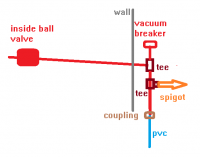JMingrone
Member
Without drilling a hole through my foundation, what would be the best way to pipe water from the faucet to the pvc stub seen in the picture? The stub takes a 90 degree bend under the pavers and goes to a yard hydrant about 25 ft away. I'm handy with plumbing, just unsure how to do this without it looking kludgey as its in a visible location.
Thanks,
Jay

Thanks,
Jay

